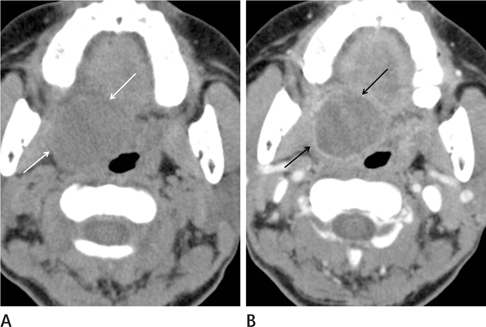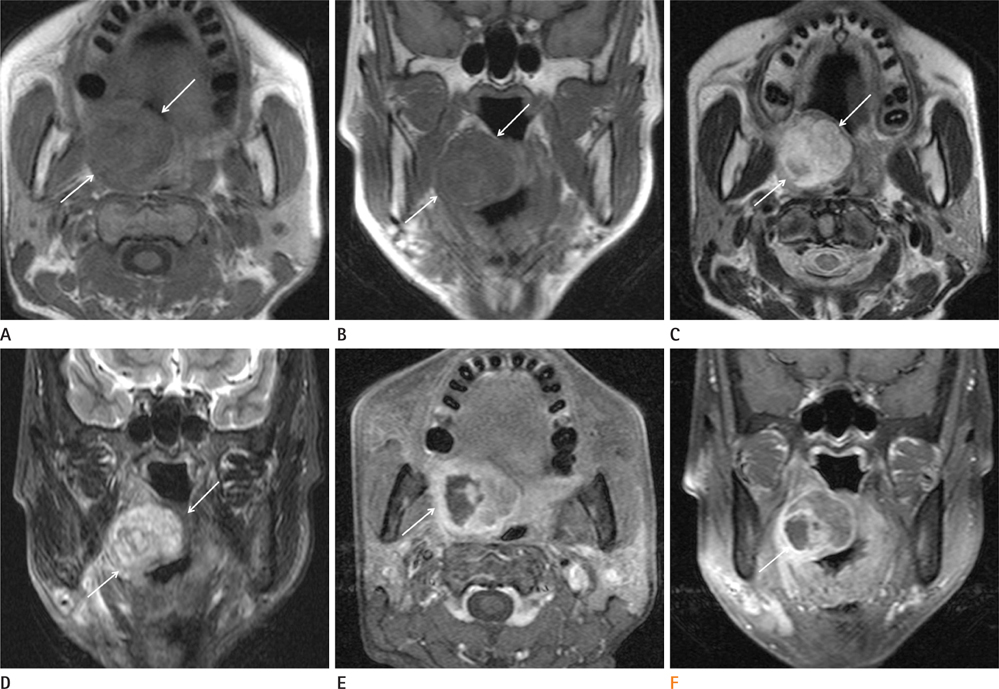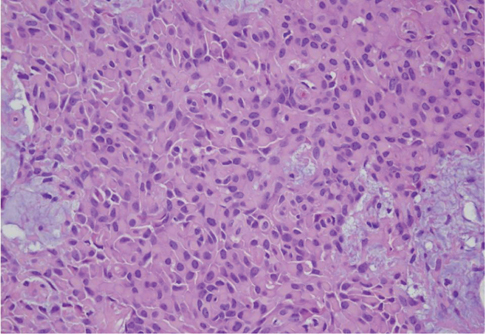J Korean Soc Radiol.
2011 Jul;65(1):23-26. 10.3348/jksr.2011.65.1.23.
Computed Tomography and Magnetic Resonance Imaging of Myoepitheliloma in the Soft Palate: A Case Report
- Affiliations
-
- 1Department of Radiology, Eulji University Hospital, Daejeon, Korea. midosyu@eulji.ac.kr
- 2Department of Pathology, Eulji University Hospital, Daejeon, Korea.
- 3Department of Otorhinolaryngology, Eulji University Hospital, Daejeon, Korea.
- KMID: 1443489
- DOI: http://doi.org/10.3348/jksr.2011.65.1.23
Abstract
- We report the appearance of myoepithelioma arising from minor salivary glands in the soft palate observed on computed tomography (CT) and magnetic resonance imaging (MRI). CT, the tumor was round with a smooth and partial lobulating contour, and slightly marginal contrast enhancement. On T1-weighted images, the mass had heterogeneous iso-signal intensity compared to the pharyngeal muscle. Additionally, the tumor had heterogeneously high T2 signal intensity with heterogeneously strong enhancement on the Gd-enhanced T1-weighted image. Radiologists should consider myoepithelioma in the radiological differential diagnosis of soft palate tumors.
MeSH Terms
Figure
Reference
-
1. Kim HS, Lee WM, Choi SM. Myoepitheliomas of the soft palate: helical CT findings in two patients. Korean J Radiol. 2007; 8:552–555.2. Wang S, Shi H, Wang L, Yu Q. Myoepithelioma of the parotid gland: CT imaging findings. AJNR Am J Neuroradiol. 2008; 29:1372–1375.3. Katsuyama E, Kaneoka A, Higuchi K, Takasu K. Myoepithelioma of the soft palate. Acta Cytol. 1997; 41:1856–1858.4. Seifert G, Brocheriou C, Cardesa A, Eveson JW. WHO International Histological Classification of Tumours. Tentative Histological Classification of Salivary Gland Tumours. Pathol Res Pract. 1990; 186:555–581.5. Monzen Y, Fukushima N, Fukuhara T. Myoepithelioma and malignant myoepithelioma arising from the salivary gland: computed tomography and magnetic resonance findings. Australas Radiol. 2007; 51:B169–B172.6. Hiwatashi A, Matsumoto S, Kamoi I, Yamashita H, Nakashima A. Imaging features of myoepithelioma arising from the hard palate. A case report. Acta Radiol. 2000; 41:417–419.7. Suba Z, Németh Z, Gyulai-Gaál S, Ujpál M, Szende B, Szabó G. Malignant myoepithelioma. Clinicopathological and immunohistochemical characteristics. Int J Oral Maxillofac Surg. 2003; 32:339–341.8. Savera AT, Sloman A, Huvos AG, Klimstra DS. Myoepithelial carcinoma of the salivary glands: a clinicopathologic study of 25 patients. Am J Surg Pathol. 2000; 24:761–774.9. Pons Vicente O, Almendros Marqués N, Berini Aytés L, Gay Escoda C. Minor salivary gland tumors: a clinicopathological study of 18 cases. Med Oral Patol Oral Cir Bucal. 2008; 13:E582–E588.




